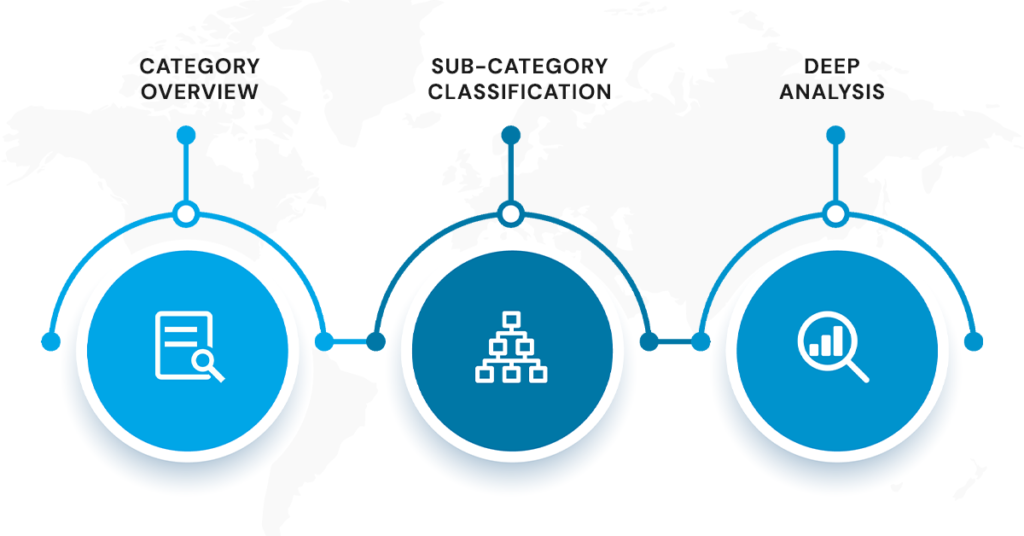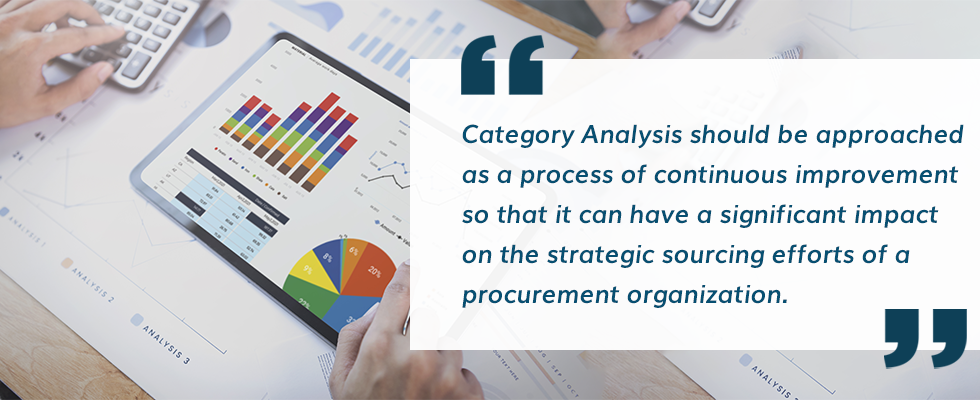Inhaltsverzeichnis
ToggleWhat is Category Analysis and What is the importance of Category Analysis in Strategic Sourcing?
“Customers” and “Categories” are the two sides of the Strategische Beschaffung coin. Every Sourcing organization desiring or claiming to be Strategic needs to align its strategies based on customer needs and design its sourcing strategies based on the Categories. While customer needs to define the external-facing strategies, categories guide the internal processes and strategies. Category Analysis is one of the most important and successful approaches for developing an efficient supply chain.
Advanced Category Analysis techniques can help businesses in evaluating millions of data points and analyze even the smallest but most important links between demand for various commodities in their portfolio.
What is Category Analysis?
The technique of categorizing goods and services in order to analyze and identify opportunities is known as Category Analysis. Category Analysis needs to start with a high-level view and drill down to specific sub-categories and segments. It helps businesses in getting a complete understanding of the demand and supply markets for most of the categories and the specific approaches to be followed for every group.

Why Category Analysis?
Most of the sourcing organizations source goods and services across a wide spectrum of categories. A one-size-fits-all approach does not work for such a disparate set of Categories. Category Analysis comes in handy to identify the uniqueness of categories leading to the appropriate choice of sourcing strategy(ies).
An improved Kategorie Management process not only facilitates in-depth study and evaluation of the supply markets but also assists in analyzing various supplier locations and tracking supplier performance. It focuses on several areas of spend and provides critical data for organizations to modify their procurement approach and find the best suppliers for their business according to their needs. This is one of the primary reasons why some of the best Sourcing Organizations are embracing Category Management solutions to enhance profitability.
Importance of Category Analysis in Strategic Sourcing
As an Effective Starting Point
Dynamic and agile Category Management Strategies supplement the reflexive strategic sourcing techniques excellently. Effective Category Analysis is, in fact, an important part of strategic procurement Management.
Three fundamental yet interconnected activities comprise a successful Strategic Sourcing and Procurement process – Category Planning & Analysis, Sourcing and Supplier Performance Measurements.

More importantly, Strategic Sourcing starts with category planning and analysis. Any Strategic Souring endeavor will be ineffective unless the initial stage leads to the identification of relevant categories, their sub-categories, and followed segments.
Following are some of the key factors to be considered during this analysis phase
- Cost and value drivers
- Expenditure
- Partners and
- Market potential and capacity
The information obtained up to this point then guides key decision making, such as make or buy. Understanding where gaps exist in the current practice is a secondary effort since Category Analysis is more concerned with how the process “should” be than how it “is”. The data is then utilized to find possibilities along the process, including opportunities to spend less by adopting smart purchasing practices. The insights gained through Category Analysis and the opportunities discovered are subsequently combined into a category plan. The category plan will help to explain the category’s strategic direction to all stakeholders and formulate an execution plan for each category.
Analytics in Category Planning
Category Analysis and Category Management are frequently linked in procurement. A Category Manager or a team of specialists use Sourcing and Procurement Analytics reports to manage and track an organization’s expenditure and supplier patterns over time, or to find new possibilities to enhance Category performance. Cost Map of expenditures & Suppliers, Kraligic Matrix and KPI Trees are some of the frameworks that can be used for structuring an effective Category Analysis.
Category level metrics can include:
- Managed spending per category
- The number of suppliers in the category
- Average payment term per category
- How many vendors handle 80% of category spend?
- Region-based spend spread
- Tail spend of Category
- Sourcing Rationale within Categories
- Contracted vs Non-Contracted spend within Categories
Various types of data visualizations such as drill-down pie-charts by spend or unit, double bar graphs for the present year vs last year or by month, stacked bar graphs, etc can be used to gain actionable insights on specific categories.
As a measure of Continuous Improvement
A Sourcing Strategy identified as part of the initial planning stage seldom continues to work in the long term. Given the speed and frequency of supply chain interruptions and customer innovations, the adoption of continuous improvement is key to sustainable business success.
Continuous Category Analytics should be part of such continuous improvement practices and should involve a comparison of organizational strategy vis-à-vis industry standards across the space and time domains.
Some key questions to consider are:
- Has there been any significant change in the Category spend contribution over a period of time?
- Are we achieving industry-standard savings under every Category?
- Any impact on specific Categories foreseen due to geopolitical changes?
- Are our risk mitigation strategies in line with industry best practices within every Category?
Automating Category Analysis

So far, we’ve discussed the category analysis workflow:
- Consolidating disparate data to form a single source of information
- Determining critical performance factors by analyzing all data combinations
- Creating insights about categories and brands
When carried out manually, all these processes need category teams to combine, analyze, and interpret data and visuals in order to provide detailed insights. These kinds of work are monotonous, challenging, and time-consuming. Businesses may make these activities easier by employing augmented analytics to automate operations.
Advanced augmented analytics, automation, and AI (Artificial Intelligence) are all transforming how we acquire, analyze, and use data. Such technologies enable sourcing teams to derive greater value from their category management strategy. However, it is critical to understand what and how to employ the right technology for your business.
Automated sourcing and procurement data analysis tools adopt a holistic approach to generate KPI trees by combining data analysis, insights and relationships to undiscovered data across various data sets. Such meaningful insights can bring crucial metrics to light, place KPIs in the perspective of bigger trends, and explain not only the category in detail but ‘why’ there is a need for such a category as well. This “why” is crucial since it contextualizes performance drivers.
Benefits of Category Analysis for strategic sourcing
Category Management comprises category data analysis, which is an important tool for any business looking to expand. Working with Category Management allows a firm to optimize its structure, gain a complete view of expenditures and supply chains, and predict market conditions. It makes it possible:
- To make working with suppliers easier because the data gathered during the analysis may be used in business negotiations.
- To customize categories based on customer requirements as well as the organization’s budget and production.
- To foresee risks and issues and design strategies to mitigate them.
- To effectively utilize human resources through efficient category management and analysis.
- To allocate business resources appropriately according to the devised strategies, products, market analysis and trends contributing to the company’s success.
Conclusion

A detailed Category Analysis requires simple processes backed by the correct technology, extensive training, and appropriate business models that can provide category managers with the information they need. Category Analysis should be approached as a process of continuous improvement so that it can have a significant impact on the strategic sourcing efforts of a procurement organization.
Please feel free to Kontaktieren Sie uns if you would like to learn more about how category management & analysis can help you achieve operational excellence by providing in-depth insights into crucial components of strategic sourcing.




2 Kommentare
You article is very valuable for me. Hoping to read more. Thank you.
Thanks for your comment. We are glad that you find this article valuable! Keep reading!